Fairview Cemetery Stroll 2023
Fairview Cemetery is a public cemetery owned and operated by the City of Ann Arbor. The Cemetery Stroll is an opportunity for community members to visit the cemetery and learn about Ann Arbor History!
In this activity, participants are invited to walk through the cemetery and visit seven sites that have been identified as significant to Ann Arbor or Fairview Cemetery history. Beginning in mid-April, each site will have a staked sign with information related to the notable person or site. In addition to those identified, many important and interesting residents are located at Fairview Cemetery. Email us at
[email protected] to suggest a grave site for us to highlight. Select the photo below to view an enlarged version.
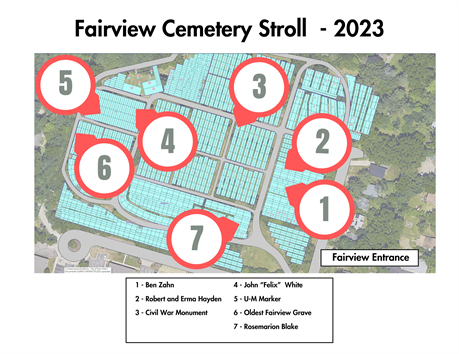
Site 1: AAFD Fire Chief Benjamin Zahn Sr. (1894 – 1976)
Fire Chief Benjamin Zahn Sr. was buried at Fairview in 1976. Benjamin Zahn was a lifelong Ann Arbor resident and retired from the Ann Arbor Fire Department after more than 38 years of service. Chief Zahn served as Fire Chief from 1939 to 1955, one of the longest serving chiefs. While Benjamin Zahn Sr. served as Fire Chief in the early 1900s, the Zahn name remained on the roster for long after that! Benjamin J. Zahn Jr. worked for AAFD, his son Benjamin J. Zahn III worked for AAFD , and Lt. Benjamin Zahn IV works out of Fire Station 3 on the west side of the City.
Photo Credit: Donated to the AADL by the Ann Arbor News. © The Ann Arbor News.
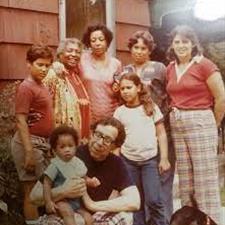
Site 2: Erma Hayden (1911-1994)
Erma Hayden was a concert pianist, composer, and teacher born in Philadelphia, PA and later a Detroit, MI resident where she met her husband Robert Hayden. Erma and Robert were married in 1940 and moved to Ann Arbor one year later for Robert to attend graduate school at the University of Michigan. Shortly after, they had their only child, Maia Hayden, in 1942. The Haydens remained in Ann Arbor until 1946, when they moved to Nashville, TN, where Erma worked as the supervisor of music for the Nashville public school system. She was the first African American to hold this position. Throughout her life, Erma Hayden was also closely involved with the Bahá'í Faith. In 1969, the Haydens returned to Ann Arbor. Their home is in Lower Burns Park and was recently designated as the City's 15th historic district. Read the
Preliminary Historic District Study Committee Report for more information this historic designation.
Site 2: Robert Hayden (1913 – 1980)
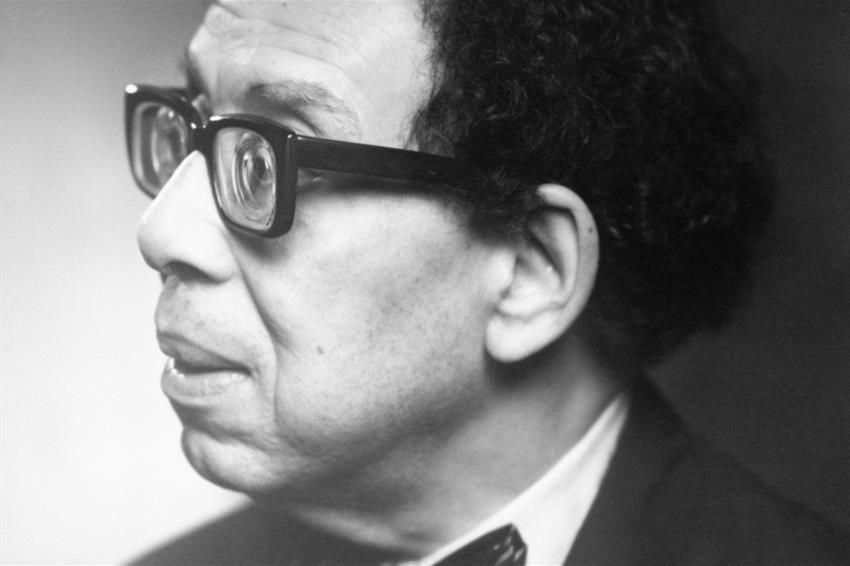 Robert Hayden was a poet, educator, and essayist born in Detroit where he grew up and attended Detroit City College (now Wayne State University). He worked for the Federal Writers’ Project during the Great Depression and later finished his degree at the University of Michigan. After graduating from the University of Michigan, Robert Hayden continued to teach and write at Fisk University in Nashville, TN. Much of Hayden’s work describes Black history and experience, politics, nature, and his Bahá’í Faith. The Haydens returned to Ann Arbor in 1969. Robert Hayden served as Consultant in Poetry to the Library of Congress from 1976 to 1978, a role known today as US Poet Laureate. He was the first African American writer to hold the office. Link:
More Information about Robert Hayden
Robert Hayden was a poet, educator, and essayist born in Detroit where he grew up and attended Detroit City College (now Wayne State University). He worked for the Federal Writers’ Project during the Great Depression and later finished his degree at the University of Michigan. After graduating from the University of Michigan, Robert Hayden continued to teach and write at Fisk University in Nashville, TN. Much of Hayden’s work describes Black history and experience, politics, nature, and his Bahá’í Faith. The Haydens returned to Ann Arbor in 1969. Robert Hayden served as Consultant in Poetry to the Library of Congress from 1976 to 1978, a role known today as US Poet Laureate. He was the first African American writer to hold the office. Link:
More Information about Robert Hayden
Site 3: Ann Arbor Civil War Monument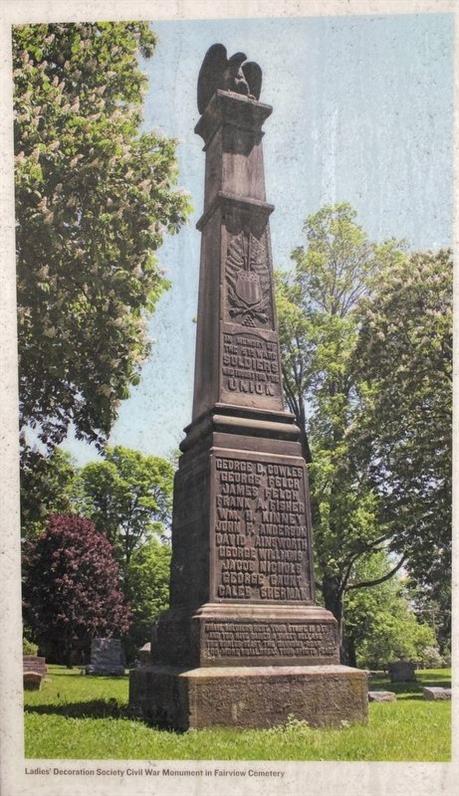
The Ann Arbor Civil War Monument was erected in 1874, nine years after the Civil War ended to commemorate those who served from Ann Arbor’s 5th Ward. The monument was funded by the Ladies’ Decoration Society. Ward 5 had the highest numbers of enlisted soldiers in the City, with 75 enlistments out of a district of 140 voters. Of those who served, 41 fallen soldiers are listed on the monument, including some who were never returned to Ann Arbor or buried in Fairview. Before this monument was erected, women in the Fifth Ward (the Ladies Decoration Society) decorated the graves on Decoration Day, which is now called Memorial Day. Inscribed on the sides of the monument are "In memory of the 5th Ward Soldiers who fought for the Union."
Photo Credit: Photographer: J.T. Lambrou Taken: September 10, 2021
Site 4: John “Felix” White (1820 – 1905)
John “Felix" White was an enslaved man in Boone County, Kentucky, who escaped to freedom in 1844 through the Underground Railroad network. White had been the property of notorious slave trader George Washington Brasher. Following his escape to the north, White attended the Raisin Institute, which taught students practical life skills, such as agricultural cultivation and domestic tasks. Later in life, he came back to Michigan to work at the Watkins Farm in Brooklyn, Michigan (UGRR) and finally settled in Ann Arbor in 1855 as a laborer in the Fifth Ward. John “Felix" White's grave site at Fairview Cemetery is now a part of the
National Underground Railroad Network to Freedom.
His Journey to Ann Arbor: John White was born in Virginia, sold to a family in Boone County, Kentucky then resold to George Washington Brasher of Benton County, Kentucky in 1844. While waiting in Peterburg, Kentucky John escaped by crossing the Ohio River, and landed in Rising Sun, Indiana. Where African American, Samuel Barkshire, part of the Underground Railroad (UGRR) suggested he go to Levi Coffins' farm in Newport, Indiana (UGRR). From there, he moved to the Haviland Institute in Lenawee Township, he relocated to Ontario Canada. Later he came back to Michigan to work at the Watkins Farm in Brooklyn, Michigan (UGRR). Married in Detroit, relocated back to Sandwich Canada, then returned to Farmington, Michigan and finally settled in Ann Arbor in 1855 as a laborer in the Fifth Ward.
More Information about John “Felix" White and his connection to Ann Arbor History can be found at this
link.
Site 5: Dr. David E. Lord (1795 – 1830)
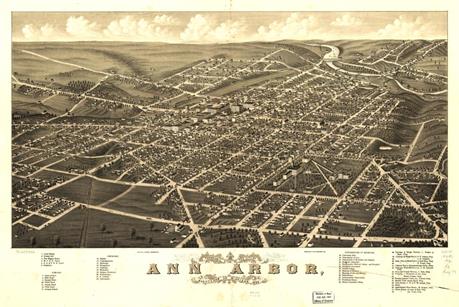
Originally buried in Felch Cemetery in 1830, Dr. Lord was later reburied in Fairview Cemetery when Felch Cemetery was transformed into Felch Park. Dr. Lord was the first doctor in Washtenaw County. He also served as County Clerk from 1827 to 1830. Pictured here is a panoramic view of the City of Ann Arbor in 1880.
Photo Credit: Library of Congress, Geography and Map Division.
Site 6: Rosemarion Blake (1923 – 2015)
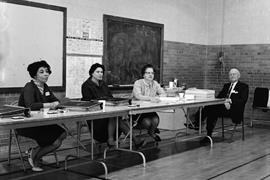
Rosemarion Blake was a long time Ann Arbor resident and had a lifelong career in community service. Blake was the first Black woman to work at City Hall in a non-custodial position where she worked as a clerk in the City Treasurer's Office. Later in life, she was regarded as an important local historian, holding leadership positions in various organizations like the Historic District Commission and the Ann Arbor Historical Foundation. She also served on the board of the Washtenaw County Historical Society and as chairwoman of the board of the Ann Arbor Transportation Authority (AATA).
Link to: African American Cultural and Historical Museum of Washtenaw County Oral History Project:
Interview with Rosemarion Blake February, 2013
Photo: Rosemarion Blake, Helen Waters, Lucille Fisher, and John Modlin working the primary election, February 1967 Photographer: Eck Stanger. Copyright Protected: Ann Arbor News
Site 7: University of Michigan Anatomical Donors (1915 – 1963)
The University of Michigan Medical School Anatomical Donations Program allowed a person to donate their body to the medical school for practice and research. Upon the conclusion of the research and use by U-M, the bodies were laid to rest at Fairview Cemetery. The University of Michigan has little to no records of those persons who were donated to the program from 1915 to 1942, meaning most of the bodies buried in this section of Fairview are Jane or John Does.
Link to View Photos of the Gravesites:
Photos of Grave Sites
Link for more information about the University of Michigan's Anatomical Donations Program:
Anatomical Donations Program
